
Ptah is an ancient Egyptian deity, a creator god and patron deity of craftsmen and architects. In the triad of Memphis, he is the husband of Sekhmet and the father of Nefertem. He was also regarded as the father of the sage Imhotep.

Meretseger was a Theban cobra-goddess in ancient Egyptian religion, in charge with guarding and protecting the vast Theban Necropolis — on the west bank of the Nile, in front of Thebes — and especially the heavily guarded Valley of the Kings. Her cult was typical of the New Kingdom of Egypt.

This is an index of Egyptian mythology articles.

El-Assasif is a necropolis near Luxor on the West Bank at Thebes, Egypt, Upper Egypt. It is located in the dry bay that leads up to Deir el-Bahari and south of the necropolis of Dra' Abu el-Naga'.

The Stele of Ankh-ef-en-Khonsu is a painted, wooden offering stele located in Cairo, Egypt. It was discovered in 1858 by François Auguste Ferdinand Mariette at the mortuary temple of the 18th Dynasty Pharaoh Hatshepsut, located at Dayr al-Bahri. It was originally made for the Montu-priest Ankh-ef-en-Khonsu i, and was discovered near his coffin ensemble of two sarcophagi and two anthropomorphic inner coffins. It dates to circa 680–70 BCE, the period of the late 25th Dynasty/early 26th Dynasty. Originally located in the former Bulaq Museum under inventory number 666, the stele was moved around 1902 to the newly opened Egyptian Museum of Cairo, where it remains today.

The Temple of Ptah is a shrine located within the large Precinct of Amun-Re at Karnak, in Luxor, Egypt. It lies to the north of the main Amun temple, just within the boundary wall. The building was erected by the Pharaoh Thutmose III on the site of an earlier Middle Kingdom temple. The edifice was later enlarged by the Ptolemaic Kingdom.
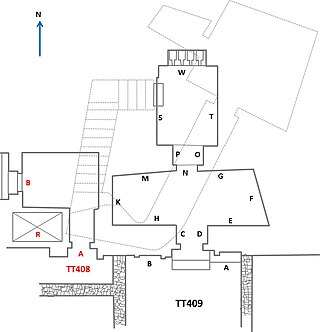
The Theban Tomb TT409 is located in El-Assasif, part of the Theban Necropolis, on the west bank of the Nile, opposite to Luxor. It is the burial place of the ancient Egyptian Samut called Kyky, who was Accountant of Cattle of the Amun domain, during the reign of Ramesses II during the Nineteenth Dynasty.
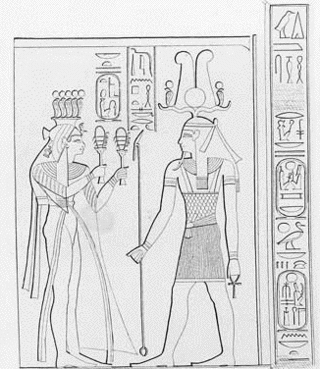
Iset Ta-Hemdjert or Isis Ta-Hemdjert, simply called Isis in her tomb, was an ancient Egyptian queen of the Twentieth Dynasty; the Great Royal Wife of Ramesses III and the Royal Mother of Ramesses VI.

Hornedjitef was an ancient Egyptian priest in the Temple of Amun at Karnak during the reign of Ptolemy III. He is known from his elaborate coffins, mummy mask and mummy, dating from the Early Ptolemaic Period and excavated from Asasif, Thebes, Egypt, which are all held in the British Museum. These related objects were chosen as the first of the hundred objects selected by British Museum Director Neil MacGregor in the 2010 BBC Radio 4 series A History of the World in 100 Objects.
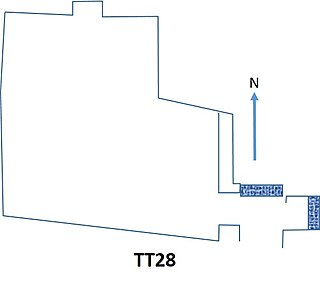
The Theban Tomb TT28 is located in El-Assasif. It forms part of the Theban Necropolis, situated on the west bank of the Nile opposite Luxor. The tomb is the burial place of the ancient Egyptian official, Hori.
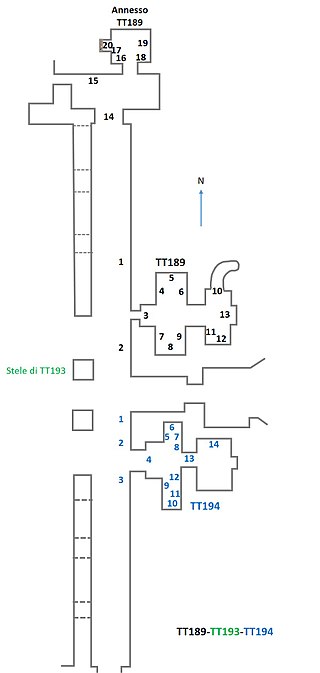
Tomb TT189 is located in the necropolis of El-Assasif in Thebes, Egypt. It contains the sepulchre of Nakhtdjehuty, who was an overseer of the carpenters of the northern lake of the god Amun and the head of the goldworkers in the Estate of Amun during the 19th Dynasty reign of Ramesses II. Nakhtdjehuty's tomb is part of the TT192 tomb complex.
This page list topics related to ancient Egypt.
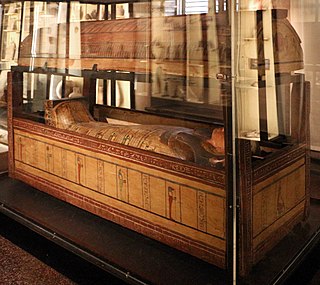
Tjesraperet was the wet nurse of a daughter of the Nubian king Taharqa. She is mainly known from her burial which was found undisturbed.

Pedubast was an ancient Egyptian official during the 26th Dynasty. He is so far only known from his burial, found within the larger and earlier tomb complex of the mayor of Thebes Karabasken (TT391), located at South El-Assasif within the Theban Necropolis, in Upper Egypt.
Pedubast's burial was found in 2015 and announced shortly after. He was most likely the grandson of the well known chief steward of the God's Wife Pabasa who was buried in another large funerary complex at Thebes (TT279). Pedubast was overseer of Upper Egypt and chief steward of the God's Wife; in the latter position he managed the estates of the God's Wife of Amun, the leading religious figure in southern Egypt at the time. Pedubast only reinscribed some parts of the burial chapel of Karabasken. It seems that he was only for a short time in office having not enough time to build an own monumental tomb. The newly decorated parts include a door frame and a sun hymn. Fragments of his coffin were found too.

The Theban Tomb TT68 is located in Sheikh Abd el-Qurna, part of the Theban Necropolis, on the west bank of the Nile, opposite to Luxor. The tomb was initially started for the High Priest of Amun Meryptah, during the 18th Dynasty. The tomb was later built over by Paenkhemenu during the 20th Dynasty. During the 21st Dynasty the tomb was again usurped by Nespaneferhor and his son Hor.

The Theban Tomb known as MMA 56 is located in Deir el-Bahari. It forms part of the Theban Necropolis, situated on the west bank of the Nile opposite Luxor. The tomb is the burial place of the ancient Egyptian Lady Ankhshepenwepet, also called Neb(et)-imauemhat, who dates to the 25th Dynasty. Ankhshepenwepet was a Singer in the Residence of Amun and an attendant of Shepenwepet I. It was excavated by Herbert E. Winlock on behalf of the Metropolitan Museum of Arts in 1923–24.
The Theban Tomb known as MMA 60 is located in Deir el-Bahari. It forms part of the Theban Necropolis, situated on the west bank of the Nile opposite Luxor. The tomb is the burial place several high ranking individuals dating to the 21st Dynasty.
North Asasif – is a part of the Theban Necropolis located on the bottom and sides of the valley, along the processional ways leading to the royal temples in Deir el-Bahari: temples of Mentuhotep II, Hatshepsut, and Thutmose III. It encompasses private tombs dating from the Middle Kingdom to the Ptolemaic period. Evidence has been found of strong ties between Asasif and Deir el-Bahari through the ages.

Tomb TT406, located in the necropolis of El-Assasif in Thebes, Egypt, is the tomb of Piay, a scribe of the offering table of the Lord of the Two Lands dated to the Ramesside period. It is located in El-Assasif, part of the Theban Necropolis.

The Theban Tomb TT120 is located in Sheikh Abd el-Qurna. It forms part of the Theban Necropolis, situated on the west bank of the Nile opposite Luxor. The tomb is the burial place of the ancient Egyptian official Ahmose, who was the second prophet of Amun-Ra at Karnak and later the first prophet of Amun at Henqet-Ankh, the mortuary temple of Tuthmosis III at Qurnah during the reign of the Tuthmosis III.

















